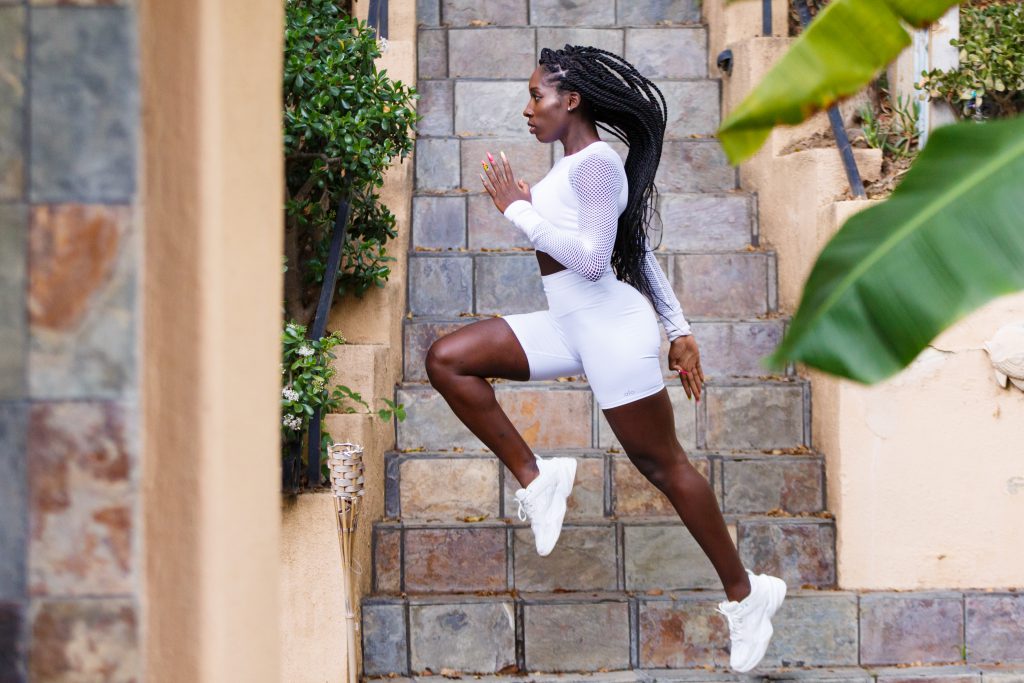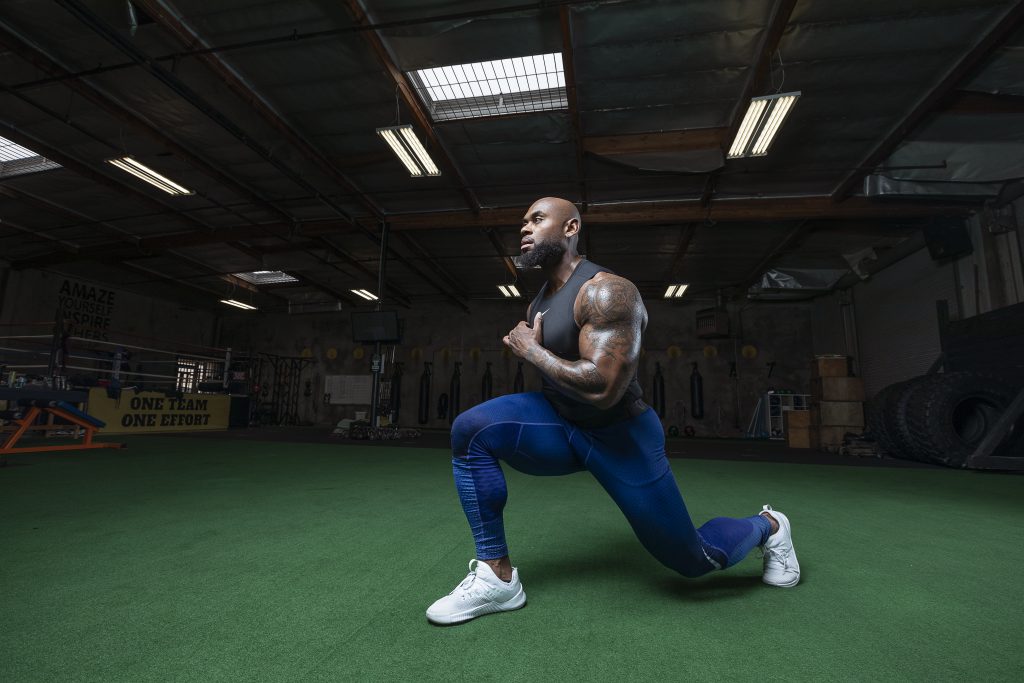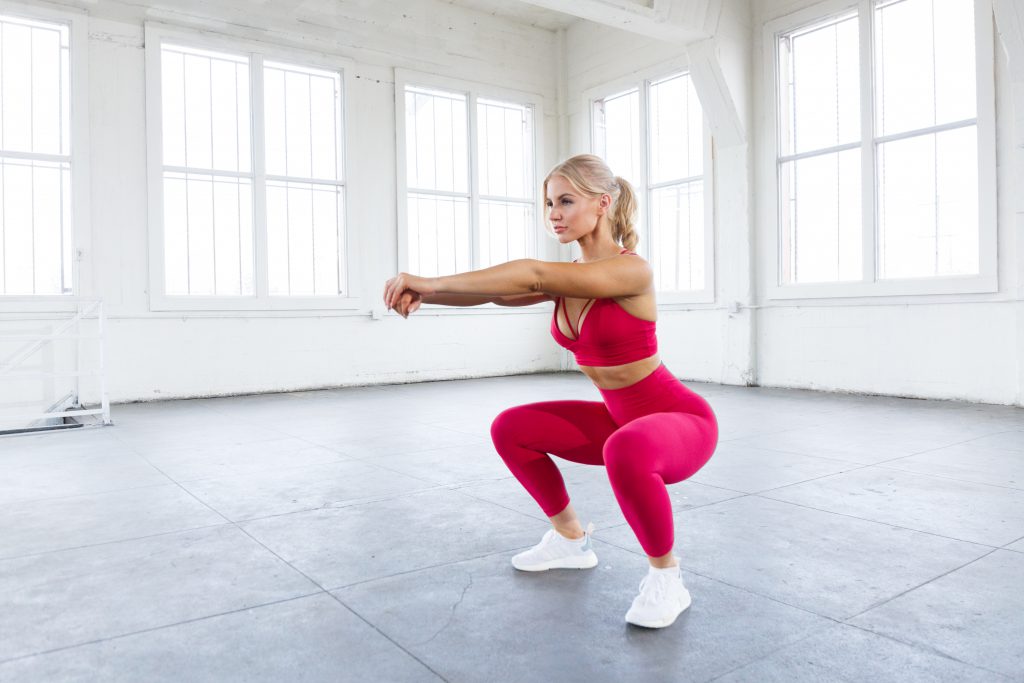You’ve seen them – they swarm gyms in droves, striking poses in full-length mirrors and occupying the bench press for hours on end. Triumphant after deadlifting twice their body weight, they clench their fists and roar, alarming everyone in the room. After years of training and a metric ton of protein shakes, these lifters have reached the zenith and bask in the glory of bodybuilding perfection.
And then they practically lose their breath just walking up the stairs.
You might call it “useless muscle” – it can happen if you’re too scared cardio will crush your gains, causing you to skip leg day. You might get the sculpted muscles you want and still be unfit for all intents and purposes.
Not to fear, though. You can avoid that grim fate with these 7 leg exercises that will improve your cardiovascular function and athletic performance. If you’re less than satisfied with your body’s endurance levels, throw some of these leg workouts into your training program and you’ll have strong legs capable of supporting the muscle mass of your upper body during strenuous physical activity.
(Note: Want our elite trainers to help you tone and strengthen your legs? Start your Fitplan free trial today!)
Leg Workouts vs Endurance Training
If you’re trying to stimulate muscle growth, you need to be careful about how you fit cardio into your workout routine. Your body might consume muscle mass as an energy source if it doesn’t have anywhere else to get the energy to power the exercises.
That being said, cardio will not automatically kill your gains.
Adding the right kind of cardio – that is, explosive plyometrics and short bursts that will keep your heart rate up – can boost your muscle growth. Long-distance running and similar endurance training is the kind that you’ll want to steer away from if you’re trying to grow muscle.
How Do Leg Workouts Boost Endurance?
Even if you do great compound exercises like deadlifts fairly often, you still need to have a dedicated leg day to make sure you’re targeting specific muscles in the lower body and not relying on compound exercises to activate them incidentally.
The good news for people who are fixated on their arms, shoulders, or chest is that you can easily bring them into the mix by holding dumbbells or kettlebells during these leg exercises.
To cause hypertrophy, you need to damage your leg muscles. In the process of repairing themselves, your muscles will get bigger. Exercises that target the lower body tend to build endurance because they frequently include more cardio.
It’s hard to imagine getting out of breath doing a biceps curl but it can easily happen at the end of a set of lunges, especially if you’re adding plyometric movement to the exercise.
Helpful Hint: Get a high-intensity workout with our Bodyweight HIIT At Home Fitplan!

Health Benefits of Strong Leg Muscles
Building muscle in your lower body will do more than just improve your endurance and athletic performance. It will also help your circulatory system pump blood around the body and improve your balance.
To a certain point, the amount of muscle you have will increase these benefits. One Danish study found that people with larger thighs had a lower risk of heart disease and premature death than people with thin thighs.
Big muscles like the hamstrings and quadriceps are the most important to target for better balance. If you walk on uneven surfaces or trip over something, these two muscles are going to help you stay upright.
(Note: You can download the Fitplan App for free on Google Play!)
What Kind of Leg Exercises Work Best?
You should use lower body exercises that mimic the type of movement you’re trying to improve on. Cycling is better than running if you want to improve your joint flexibility, for example, so if you want to improve your squat or deadlift performance you’d be better off on the cycling machine.
The intensity of the workout is also important. If you’re focusing on building up your endurance with these leg exercises, then the workout should be divided into high reps of long motions. The best thing you can do to build muscle is to keep strain on your muscles, so include isometric pauses in your leg exercises wherever possible and use cable and pulley machines when you can.
Leg Exercises and Core Strength
Some leg exercises double as core-strengthening ones. Most lower-body workouts present a great opportunity to include the core for some incidental strength building. Sometimes you can accomplish this by simply engaging your core before beginning the movement.
Core strength not only helps you lift better. It also helps build endurance and improves your running economy significantly. A leg routine with your core engaged and activated is a great way to make sure you can handle a brisk run and avoid the “useless muscle” dilemma.
What To Target: Important Lower-Body Muscles
We’ve already mentioned the two largest lower-body muscles you need to target, the hamstrings and the quadriceps. Hamstrings are important because they form a significant part of the posterior chain, which runs the entire length of the back of the human body. Tight hamstrings have been known to lead to back pain and vice versa.
Quadriceps are important for balance and stability. They’re involved in flexing the thighs at the hip joint and in knee flexion, so if you’re trying to improve your deadlift you really ought to target your quads one or two days a week.
Besides these two largest leg muscles, you should also target the soleus and gastrocnemius, which you probably know by their easier moniker: the calf muscle. It helps move the heel joint during running, jumping, and walking. Exercising it can help prevent common injuries like a torn calf, pulled muscle, or a calf muscle strain.
The glutes are also very important. They aren’t just there to look nice, either. The glutes come into play whenever the hips move and they also give your spine and lower back some cushion. Depending on your body type, the glutes might also be a storage facility for fat to be used for extra energy.
Helpful Hint: Build strength throughout your entire body with our Complete Physique Pro Fitplan!
The 4 Best Leg Exercises for Warm-Ups
The best way to avoid injury is a comprehensive warm-up that will prime your muscles and get the blood flowing before you move into the more challenging moves. Skip the static stretching and try some more dynamic stretches that will open up your hip flexors, activate your glutes, and let you move your legs through their entire range of motion with ease.
Use some of these methods to get ready for your next lower-body workout and don’t forget to add them to the last few minutes of a workout routine as a cooldown.
1. Standing Calf Raises
A simple exercise to start with, calf raises are a great way to get your ankles primed for the workout to come. Standing calf raises also help with initial calf muscle activation to prevent tears or other injuries there.
The starting position doesn’t require you to do anything besides step up on a slightly raised platform and stand with your feet about hip-width apart with your heels hanging off the end. If you aren’t at the gym, a curb will do just fine. Unlike standard calf raises, standing calf raises allow your ankles a bit of negative flexion.
Slowly lift yourself by raising your heel. Make sure your toes don’t leave the platform. Add some extra difficulty with an isometric pause just after the top of the movement and use dumbbells or even hold a barbell if you want to get your upper body involved.
2. Forward Leg Swings
Activate more of your muscles for more challenging leg training with forward leg swings. All you need is a little bit of space to make sure that you can kick your leg out without hitting anyone.
This is a great exercise if you’re trying to work on balance. Forward leg swings also loosen up your hip flexors which will in turn allow your glutes to get activated. The calves, quadriceps, and hamstrings are also involved.
To do this move, you can use a railing, chair, or another support method. Swing one leg at a time out to the end of its range of motion and let momentum bring it back down and slightly behind your body until it reaches the end of its backward range of motion. Your leg and torso should both remain straight throughout this exercise to target your hip flexors.

3. Lunges
No good workout plan that’s meant to target the lower body is complete without lunges. They’re a great bodyweight exercise but you can also add weight by carrying kettlebells or using resistance bands.
To perform a lunge, start with your legs hip-width apart and your hands at your sides. Decide which leg you want to start with and then take a big step forward, slightly larger than a normal stride. Plant your forward foot flat and continue moving your torso forward, bending the knee of your forward leg as you do so.
Lower yourself down until your forward knee is at a 90° angle. Your rear leg should be straight and your forward thigh parallel with the floor. For some variation, try a walking lunge by continuing to “walk” around lunge by lunge rather than returning to the starting position.
4. Jump Rope
A great mix of cardio and leg exercises, jumping rope also primes your ankles for just about anything. The circular motion of your arms helps strengthen your hand-eye coordination and your hamstrings, glutes, delts, forearms, and core all also get some attention.
There are a ton of ways you can use a jump rope, but the traditional method is fairly straight forward. You’re going to be jumping directly up so practice landing softly to prevent injury to your ankles and knees.
Grab either end of the rope in your hands and keep your feet close together. You should minimize the distance you create between yourself and the ground. Start with the rope behind your feet and swing your arms back to bring the rope over your head and time your movement to jump over the rope when it reaches the front of your feet.
It will feel like a double jump because you’ll be landing with your ankles and then rebounding the skip over the rope when it comes back around.
Helpful Hint: Get into jump rope with our Jump Rope Follow Along Fitplan!
7 Best Leg Workouts for Mass & Strength
1. Leg Extensions
You’ll need a leg extension machine for this move. If there isn’t one handy, you can mimic the effects of leg extensions by putting weight on your shins and copying the move. A barbell balanced on the tops of your feet will activate the same muscle groups as a leg extension with a machine.
Leg extensions are some of the best exercises for targeting your quadriceps. To start, all you need to do is set your weight and sit down at the machine with the pads on your lower legs. Lift by pushing with your thighs and make sure to keep your core activated and your back straight.
Make sure you don’t fully straighten your legs as this could cause your knees to lock. If you add an isometric pause halfway back to the starting position you’ll really feel the burn.
2. Leg Press
Just like leg extensions, this one requires a specific machine. The leg press machine can be scary because it puts you in a position you’re probably not used to. Luckily, they have safety bars that keep the weight elevated until your feet are in place to hold it up.
Once you sit in the leg press machine you’ll understand this exercise intuitively. Sit with your feet flat on the underside of the platform. Release the safety bars that hold it in place and take the weight on your legs. Lower the platform until your knees are at 90 degrees and then return it to the starting position.

3. Squats
There are tons of squat variations you can use to bulk up your leg day workout routine, including the Bulgarian split squat, sumo squat, front squat, and barbell squats. You should try to learn all of these moves so you can keep your body guessing and keep the gains coming.
For this guide, we’ll concentrate on the standard back squat, also referred to as a barbell squat. It’s one of the best exercises for your glutes, hips, and lower back. Every major muscle and muscle group in your lower body will be activated by this squat variation.
Take a barbell out of the rack with it resting on your shoulder muscles, behind your head. Step back and get into a stance with your feet shoulder-width apart. Keep your core engaged and spine straight while moving your butt out as if you were going to sit down in a chair. Continue lowering until your hips are beneath your knees, then rise back to the starting position.
4. Hamstring Curls
The hamstring curl, or leg curl, is a classic part of leg day warm-ups but we’re including it in the list of regular exercises because it’s a great method of filling in break time during a HIIT workout and keeping your hamstrings loose throughout your routine.
You can do them standing or sitting using a resistance band. The standing variation is simplest. All you have to do is stand with your feet hip-width apart and your hands on your hips. Lift one foot at a time behind you until it touches your glutes.
5. Romanian Deadlift
An Olympic bodybuilder favorite, the Romanian deadlift is a variation on the classic deadlift. They’re both compound exercises that work just about every muscle group in your entire body. If you’re looking for an exercise that will work your upper and lower body and make you look like a lifting heavy weight, the Romanian Deadlift is the one.
The Romanian deadlift is the reverse of a traditional deadlift. To start, use an overhand grip to lift the barbell so that it’s at hip-level when you’re standing up straight. Push your hips back to lower the barbell to your knees and then back to the ground, making sure to keep your spine straight throughout the movement.
Rather than putting the barbell back on the ground, reverse to get back into the starting position and continue doing so for as many reps as you can.
6. Jump Squats
Unlike the traditional squats that rely on weight, jump squats use your own bodyweight and explosive plyometric energy to add some much-needed cardio to your leg day workout routine. You can also hold dumbbells in your hands to make the move more challenging.
To do a jump squat, stand with your feet hip-width apart and put your hands out to either side for better balance. Sit your butt back like you would in a normal squat. When you’re at the lowest point and about to return to the starting position, explode upward and jump, then land softly back on the ground. The faster you get back into the squat, the better the workout will be.
Helpful Hint: Boost your endurance and performance with our At Home Athlete Fitplan!
7. Glute Bridge
Although it targets the glutes, glute bridges also help work out the hamstrings, hips, and your core. You can also add weight to make it more challenging. To do this simple move, lie down on a mat with your knees bent and your feet flat on the floor. Slowly raise your hips until there’s a straight line going from your head to your knees. Hold that position for a while and then release.
Conclusion
Leg day is vital for a well-rounded bodybuilder’s physique but exercising your leg muscles is also important for a working circulatory and cardiovascular system. An even weekly workout will get you into great shape and help keep pesky fat off. If you want better endurance and improved athletic performance, use these 7 best leg workouts to build muscle mass on your legs, and avoid becoming top-heavy.
(Note: Want our elite trainers to help you plan your fitness routine? Start your Fitplan free trial today!)


